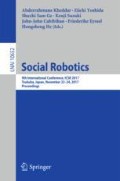Abstract
The goal of this work is to enable interactions of humans with a humanoid robot that can be customized to exhibit behaviors typically observed in children with Autism Spectrum Disorders (ASD) along different severities. In a first step, we design robot behaviors as responses to three different stimulus families, inspired by activities used in the context of ASD diagnosis, based on the Autism Diagnosis Observation Schedule (ADOS-2). We implement a total of 16 (possibly blendable) robot behaviors on a NAO humanoid robot according to different autism severities along 4 selected features from the ADOS-2. In a second step, we integrate those behaviors in a customizable autonomous agent with which humans can continuously interact through predefined stimuli. Robot customization is enabled through the specification of a feature vector modeling the behavioral responses of the robot, resulting in 256 unique customizations. Our autonomous architecture enables the robot to automatically detect and respond to parameters of the interaction such as verbal and non-verbal stimuli, as well as sound location. In a third step, we evaluate our designed isolated behaviors in the autonomous system by running a study with three experts. This work paves the way towards potentially novel ways of training ASD therapists, interactive solutions for educating people about different forms of ASD, and novel tasks for ASD therapy with adaptive robots.
Access this chapter
Tax calculation will be finalised at checkout
Purchases are for personal use only
Notes
References
APA: Diagnostic and Statistical Manual of Mental Disorders (DSM-5®). American Psychiatric Publication (2013)
Baraka, K., Melo, F.S., Veloso, M.: Simulating behaviors of children with autism spectrum disorders through reversal of the autism diagnosis process. In: Oliveira, E., Gama, J., Vale, Z., Lopes Cardoso, H. (eds.) EPIA 2017. LNCS, vol. 10423, pp. 753–765. Springer, Cham (2017). doi:10.1007/978-3-319-65340-2_61
Dautenhahn, K., Werry, I.: Towards interactive robots in autism therapy: background, motivation and challenges. Pragmat. Cogn. 12(1), 1–35 (2004)
Dawson, G., Adams, A.: Imitation and social responsiveness in autistic children. J. Abnorm. Child Psychol. 12(2), 209–226 (1984)
Dignum, F., Prada, R., Hofstede, G.J.: From autistic to social agents. In: Proceedings of the 2014 International Conference on Autonomous Agents and Multi-agent Systems, pp. 1161–1164. International Foundation for Autonomous Agents and Multiagent Systems (2014)
Falkmer, T., Anderson, K., Falkmer, M., Horlin, C.: Diagnostic procedures in autism spectrum disorders: a systematic literature review. Eur. Child Adolesc. Psychiatr. 22(6), 329–340 (2013)
Gillesen, J.C., Barakova, E., Huskens, B.E., Feijs, L.M.: From training to robot behavior: towards custom scenarios for robotics in training programs for ASD. In: 2011 IEEE International Conference on Rehabilitation Robotics (ICORR), pp. 1–7. IEEE (2011)
Ingersoll, B.: The social role of imitation in autism: implications for the treatment of imitation deficits. Infants Young Child. 21(2), 107–119 (2008)
Kenny, P., Hartholt, A., Gratch, J., Swartout, W., Traum, D., Marsella, S., Piepol, D.: Building interactive virtual humans for training environments. In: Proceedings of I/ITSEC, vol. 174 (2007)
Lord, C., Rutter, M., Dilavore, P.C., Risi, S., Gotham, K., Bishop, S.L.: Autism Diagnostic Observation Schedule, 2nd edn. Western Psychological Services, Torrance (2012)
Mitsunaga, N., Smith, C., Kanda, T., Ishiguro, H., Hagita, N.: Adapting robot behavior for human-robot interaction. IEEE Trans. Robot. 24(4), 911–916 (2008)
Rossi, S., Ferland, F., Tapus, A.: User profiling and behavioral adaptation for HRI: a survey. Pattern Recogn. Lett. (2017)
Scassellati, B., Admoni, H., Matarić, M.: Robots for use in autism research. Annu. Rev. Biomed. Eng. 14, 275–294 (2012)
Tapus, A., Peca, A., Aly, A., Pop, C., Jisa, L., Pintea, S., Rusu, A.S., David, D.O.: Children with autism social engagement in interaction with Nao, an imitative robot: a series of single case experiments. Interact. Stud. 13(3), 315–347 (2012)
Tapus, A., Ţăpuş, C., Matarić, M.J.: User-robot personality matching and assistive robot behavior adaptation for post-stroke rehabilitation therapy. Intell. Serv. Robot. 1(2), 169–183 (2008)
Van Ditmarsch, H., Labuschagne, W.: My beliefs about your beliefs: a case study in theory of mind and epistemic logic. Synthese 155(2), 191–209 (2007)
Acknowledgments
This research was partially supported by the CMUP-ERI/HCI/0051/2013 grant and national funds through Fundação para a Ciência e a Tecnologia (FCT) with reference UID/CEC/50021/2013. The views and conclusions contained in this document are those of the authors only.
We thank Jocelyn Huang and Patrick Lin for their collaboration in the development of the robot behaviors, as well as Marta Couto and Patrícia Alves-Oliveira for their help. Special thanks go to the Child Development Center at Hospital Garcia de Horta, Almada, Portugal, for their feedback on this research.
Author information
Authors and Affiliations
Corresponding author
Editor information
Editors and Affiliations
Rights and permissions
Copyright information
© 2017 Springer International Publishing AG
About this paper
Cite this paper
Baraka, K., Melo, F.S., Veloso, M. (2017). ‘Autistic Robots’ for Embodied Emulation of Behaviors Typically Seen in Children with Different Autism Severities. In: Kheddar, A., et al. Social Robotics. ICSR 2017. Lecture Notes in Computer Science(), vol 10652. Springer, Cham. https://doi.org/10.1007/978-3-319-70022-9_11
Download citation
DOI: https://doi.org/10.1007/978-3-319-70022-9_11
Published:
Publisher Name: Springer, Cham
Print ISBN: 978-3-319-70021-2
Online ISBN: 978-3-319-70022-9
eBook Packages: Computer ScienceComputer Science (R0)

